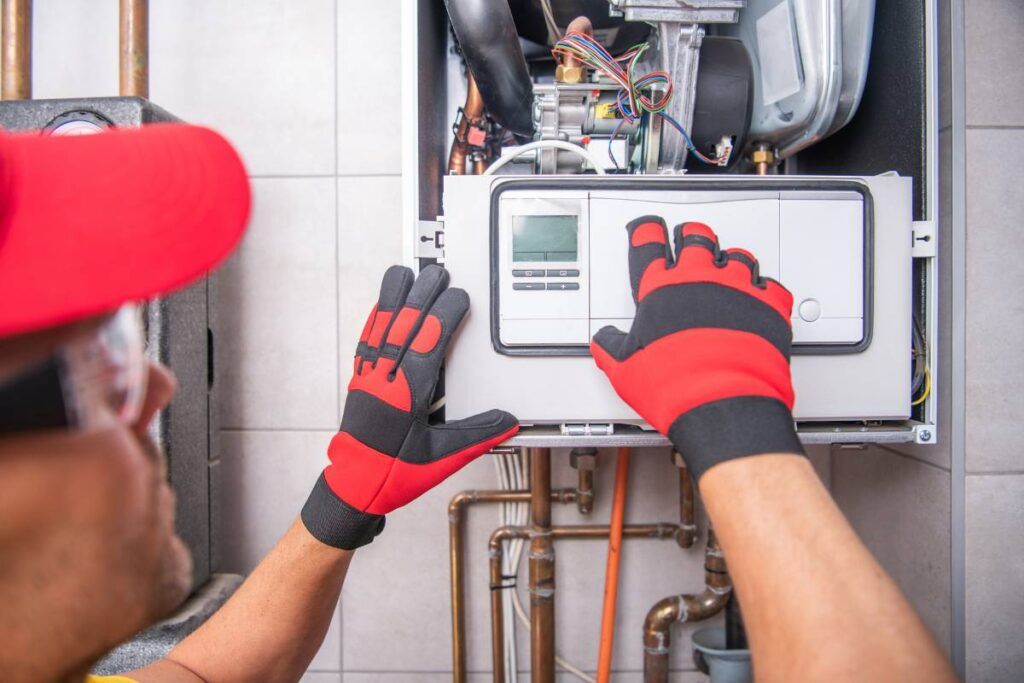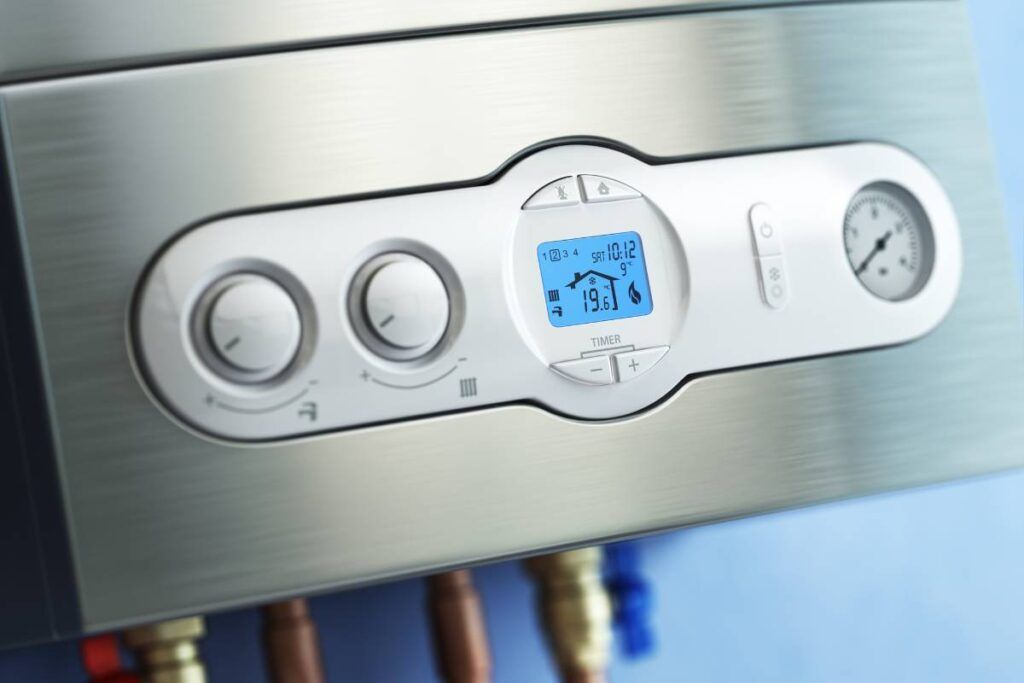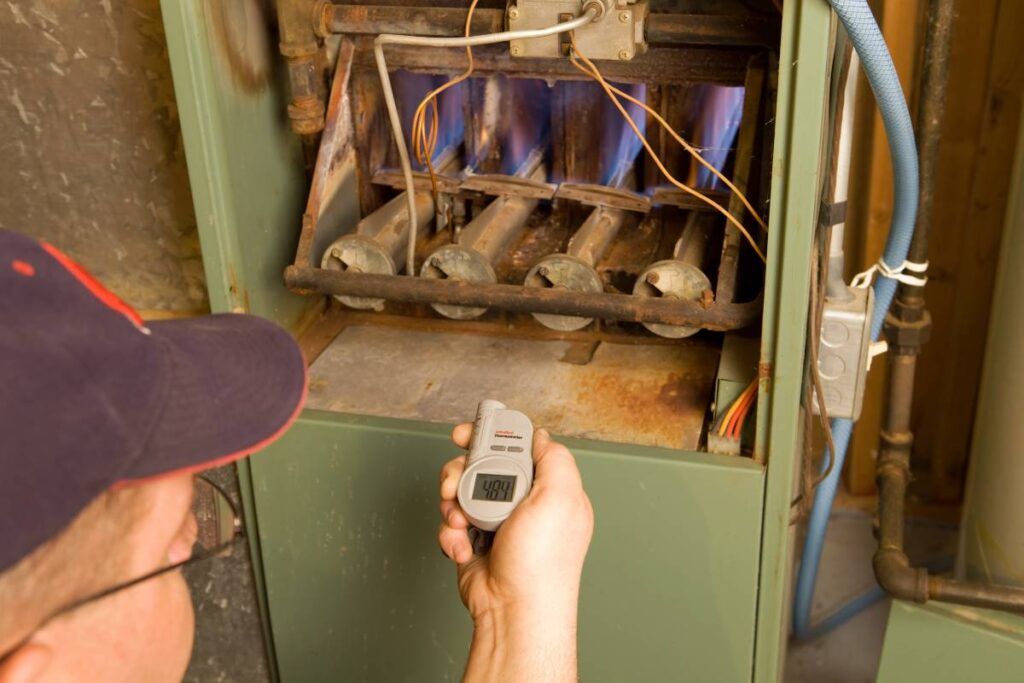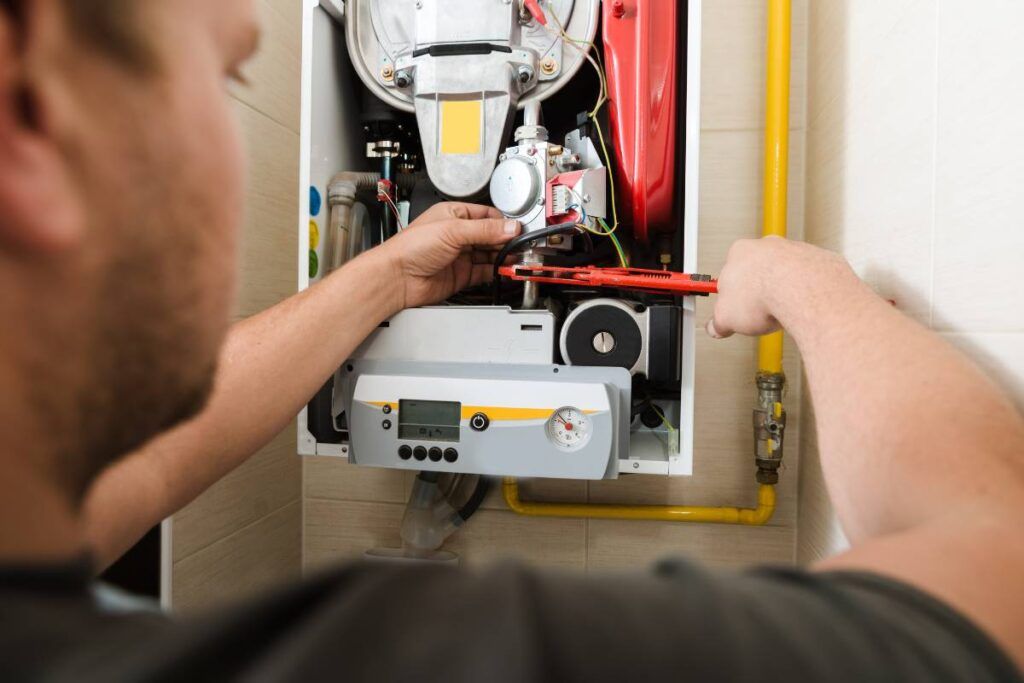Gas furnaces can keep the temperature of your house warm during the winter. When winter arrives, your gas furnace will work overtime to maintain the warmth. In that case, you must ensure it remains in good condition. But since it is a machine, it can face certain issues.
The common problems in a gas furnace are weird noises, dirty filters, furnace not starting, failed ignitor, furnace not producing enough heat, a faulty thermostat, gas leakages, and pilot lights out. Regular maintenance and replacing faulty parts when needed will help keep these problems at bay.
The list continues. You can solve some yourself, and others require experts’ consultation. In this article, we shall discuss these problems and provide a detailed troubleshooting guide for a gas furnace. So, let’s begin right away.

Check out our list of top-handpicked products for all your electrical, appliance, and HVAC system needs to keep your home running smoothly.
This post includes some affiliate links.Gas furnace problems and troubleshooting them
A furnace is an important part of the house, mostly during the winter.
So, you need to keep it safe throughout the season.
A gas is a home heating unit that runs on natural gas.
The gas ignites inside the furnace, warms up the surrounding air, and spreads throughout the house.
You will need the furnace to run most of the time in winter.
You should fix it as soon as you detect any problem in the unit.
Below I have shared some common problems a furnace can face and the simple ways to troubleshoot them:
The furnace is not starting
There could be either some serious reasons behind a furnace not starting or some silly reasons:
- You have not turned on your furnace. Your furnace will take a few seconds to start.
- The circuit breaker connected to the furnace is off or tripped. You need to turn it on or reset it.
- The thermostat is not set to heat, so the furnace is not starting.
- The thermostat has some loose wire connections. Open the thermostat and check for loose connections. If you find any, tighten them properly.
- The thermostat battery died, and it needs new batteries.
- The filter may be dirty. Some furnaces are equipped to shut down when the filter fails to allow enough airflow due to excessive dirt and debris. It can also cause serious mechanical failure. Replace the filter.
- The circuit board of the furnace is bad. Change the circuit board or find its fault and start your furnace.
So, before you start troubleshooting a furnace that does not start in some other way, consider checking these things so that you don’t end up with the wrong solution.
The furnace keeps shutting off.

You turn on the furnace, and the burner lights turn on, but the furnace immediately shuts off.
The common reasons could be:
- Some furnaces automatically shut off if the filter is dirty, and it blocks the airflow. Please take out the filter and clean it regularly or replace it.
- The flame sensor is not working, for which the burner lights, but the furnace shuts off. Change it.
- The thermostat is faulty. You need to replace the thermostat with a new one.
Consult a technician if you do not find any of the reasons above in your furnace.
Besides, they can troubleshoot the problem better than you.
The furnace gives cold air.
A furnace is supposed to produce heat. But if it is producing cold air, something is wrong with it.
Maybe the heat registers are closed for which the furnace is blowing cold air.
Check the heat registers and make sure they remain open.
A furnace could blow cold air because the gas is turned off or you are running out of it.
Check the gas cock near the furnace and ensure it is parallel to the gas line.
Check that your gas tank is full.
Call your gas supplier for a fill-up if the pressure gauge reads less than 15%.
If the position is wrong, change it and bring it to its place.
When the draft motor does not work well, it cannot pull the hot combustion through the furnace.
As a result, the furnace provides cold air.

Check the draft motor and fix it.
The furnace filter is blocked, so it cannot take in fresh air to heat it and release it. As a result, it blows cold air.
Please remove the dirty filters and clean them to let the furnace heat up your room. You can replace them if the dust and debris are too much.
Gas furnace failing to ignite.
Gas failing to ignite is another reason behind cold air.
Sometimes, you will find that you have turned the furnace on and the fan is running, but the unit is releasing cold air.
It is simply because the gas is not igniting.
In such a condition, consider resetting your furnace.
Turn the switch to the off position for 10 seconds, and then turn it on again.
Your furnace should start working and releasing warm air after some time.
If the method fails, it is time to call a professional.
The draft motor is running, but the furnace remains shut
A draft motor pulls the hot combustion gasses through the furnace and releases them out of the exhaust.
If you find that the draft motor is working well, but the furnace still won’t start, the following could be the reasons:
- The motor or the board controlling the motor has failed. You need to replace it with a new one.
- The air intake or the exhaust chimney got blocked due to snow, dirt, debris, bird’s nest, etc. Check and clear it soon so that the furnace starts working.
- There might be some problem with the gas valve or the ignitor. If the gas valve does not open, or the ignitor is not lighting, you need to replace it.
The burner starts to heat but shuts off before warming the house

The burner will start when you turn on the furnace to warm up your house.
But, if the furnace shuts off before the burner can heat your house properly, the problem could be in the flame sensor.
It could be due to corrosion.
You can fix a corrosive burner by sanding it. Still, replacement would be a permanent solution and a long-lasting fixation.
Blower running continuously
The blower should shut off once you shut down the heating unit.
But if it does not turn off, there could be 3 common reasons behind it:
- You have kept the fan switch in the ‘On’ position in the thermostat instead of ‘Auto.’ Correct it and keep it in the ‘Auto’ position.
- The relay in the control board got stuck in the closed position, for which the blower is constantly getting electricity for running. Replace the control board by hiring a professional.
- Thermostats have contacts to control the power to the furnace. If these contacts get worn out, the blower will not stop. In that case, you need to replace your thermostat.
The furnace is not producing enough heat.
Furnace comes in different sizes, determined by BTU (British Thermal Unit).
Different houses will require different sizes of furnaces.
If you have bought a furnace that is smaller than your house, it won’t be able to provide enough heat to your room.

So, you need to replace the thermostat and find the one that suits your house.
For example,
- 500 square feet – 12,000 BTU
- 1,000 square feet – 24,000 BTU
- 1,500 square feet – 36,000 BTU
The BTU size can differ based on the weather conditions of your region.
Hotter zones require a furnace smaller than it needs.
You need a larger furnace than the required size for a colder zone.
Other reasons behind insufficient heat could be:
- The filter type does not suit the furnace and blocks the airflow. You need to replace it with a new one suitable for your furnace.
- The filter might have got installed backward. Look for the arrows over the filter frame to check the direction of installation and airflow.
- The air ducts are leaking, so the furnace cannot produce enough heat. You can understand it by whistling noises. Fix it by either replacing the air ducts or sealing them.
- Another reason is dirty filters. Use washable filters so that you can wash and use them instead of buying them repeatedly.
Vents are closed or blocked.

Closed vents are another cause of insufficient heat inside the house.
A furnace works by making heat.
It then pumps the hot air out through the vents of your house to raise the house temperature.
If your furnace is on, but your house is not warming up, ensure the vents are open.
Vents are mostly located on the rooms’ floor, ceiling, or walls.
If they are closed or blocked, the house won’t receive enough heat.
If the vents are blocked, check for snow, ice, or household items quickly.
Turn off the furnace power, open the vent, and clear away the blockage of your exterior vent. Now, put back everything and turn on the furnace.
The furnace is making noises.
If a furnace is making a lot of noise, the reason could be some of the following:
- The furnace is a single-stage model, but it is running over time. You must run a furnace according to its capacity. Either get a high-capacity furnace or avoid running it over time.
- The blower motor at the lower part of the furnace is failing to work. You need to replace it with the help of a professional.
- There might be some leakage in the furnace cabinet, sheet metal plenum, or ductwork near the furnace. Tighten these parts, seal the leakage, or replace them.
The air coming out of the furnace has a bad smell.
It could be due to dirty air filters. Open the furnace and clean the air filters by brushing the dirt or cleaning them with water.
Another reason could be some small dead animal inside the system.
Troubleshooting this problem will be the job of a furnace technician.
Dirty air filter

A dirty air filter inside the furnace is one of the common reasons behind most of the abovementioned problems.
You need to clean the filter regularly.
The best option would be to buy a washable filter.
You can take it off, clean it easily with water, and place it back once the filter dries off.
Here are the steps to troubleshoot a dirty filter problem:
- Open the furnace’s external panel door.
- Remove the filter by gently sliding it out.
- Check the filter closely for darkness or discoloration.
- It is pretty dirty if you cannot see anything through the filter.
- Either replace the filter or clean it properly.
- If you are replacing it, make sure you have installed it in the direction of the airflow.
Gas furnaces have yellow or uneven flames.
The old gas furnaces used to have blue flames when turned on.
The recent gas furnaces have an electric ignition system that illuminates when necessary.
So they do not have any flames.
If you have an old model, a good gas furnace should always show blue flames when ignited.
But, if you find the flames yellow or uneven instead of blue, the reason could be dirty or blocked burners.
If you notice such a problem, you need to call an HVAC professional and make a routine for furnace and burner maintenance.
The pilot light is not turning on.
All the gas furnaces made before 2000 used to have pilot lights.
These are the furnaces that produce blue flames.
A pilot light will be lit whenever the furnace produces a blue flame.
A pilot light is controlled by a knob on the furnace’s bottom.
If the pilot light stays off, but the furnace is on, try relighting the pilot light.
You can always relight the pilot light by turning off the knob, waiting for a minute, and turning it on again. It’s a kind of resetting the light.

Another reason is the gas valve is off and not supplying enough gas to the pilot light.
A gas valve has 2 valves:
- The safety valve supplies gas to the pilot light
- The main valve supplies gas to the burner trays.
If the pilot light is off, check the gas valve and ensure it is turned on and supplying enough gas.
If you run out of gas or suspect a gas leakage, call an HVAC professional for help.
Thermostat and furnace mismatch
Some gas furnaces need electricity.
So, a mismatch in the thermostat and furnace will cause faulty furnace operations, for example, an overheated or underheated furnace, despite having proper thermostat settings.
While buying a gas furnace that needs a thermostat, make sure to match both of them.
Three thermostat types are available – millivolt, low voltage, and line voltage.
Make sure that you have chosen the correct one for your furnace.
Also check:
- Furnace Only Works After Reset: 9 Problem+Fix
- 15 Reasons Your Furnace Won’t Turn On (+Fix)
- 14 Reasons Your Furnace Won’t Turn Off (+Fix)
- 16 Reasons Your Furnace Is Not Heating (+Fix)
- 12 Reasons Your Furnace Is Blowing Cold Air (+Fix)
- 10 Reasons Why You Shouldn’t Run A Furnace Without A Filter
- 9 Reasons Your Furnace Is Short Cycling (+Fix)
- 11 Reasons Your Furnace Won’t Stay Lit (+Fix)
- 9 Reasons Why Your Furnace Shuts Off After 30 Seconds
- 31 Reasons Your furnace Smells (Different Types Of Smell+Fix)
- 25 Reasons Your Furnace Is Making Noise (Different Noises+Fix)
- 13 Reasons Your Furnace Is Leaking Water (+Fix)
Final thoughts
There are multiple problems a gas furnace can face.
There could be more than those mentioned in the article.
Since it is an important part of the house during the winter, troubleshooting the problems is very important.
You can troubleshoot some problems yourself, but most require an expert HVAC team.
Calling a professional is always wise as it can prevent expensive damages and save time.
Before you troubleshoot any problem yourself, consider finding the real cause.
Otherwise, if you fix the furnace for something that is not the real cause, you can damage the furnace.
Doing it yourself may save some money, but calling an expert will save you in other ways.
So never hesitate to consult them.
Reference: Wikipedia.
